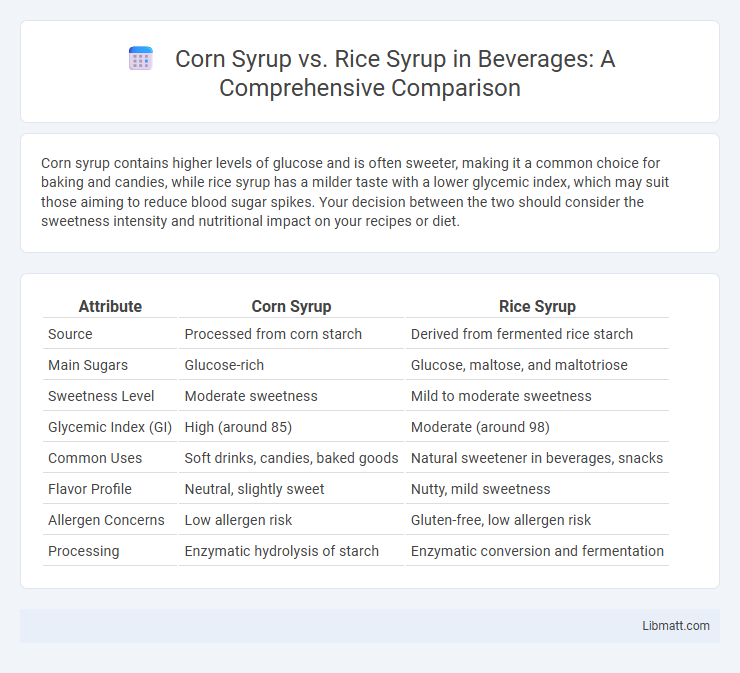Corn syrup contains higher levels of glucose and is often sweeter, making it a common choice for baking and candies, while rice syrup has a milder taste with a lower glycemic index, which may suit those aiming to reduce blood sugar spikes. Your decision between the two should consider the sweetness intensity and nutritional impact on your recipes or diet.
Table of Comparison
| Attribute | Corn Syrup | Rice Syrup |
|---|---|---|
| Source | Processed from corn starch | Derived from fermented rice starch |
| Main Sugars | Glucose-rich | Glucose, maltose, and maltotriose |
| Sweetness Level | Moderate sweetness | Mild to moderate sweetness |
| Glycemic Index (GI) | High (around 85) | Moderate (around 98) |
| Common Uses | Soft drinks, candies, baked goods | Natural sweetener in beverages, snacks |
| Flavor Profile | Neutral, slightly sweet | Nutty, mild sweetness |
| Allergen Concerns | Low allergen risk | Gluten-free, low allergen risk |
| Processing | Enzymatic hydrolysis of starch | Enzymatic conversion and fermentation |
Introduction to Corn Syrup and Rice Syrup
Corn syrup, derived from corn starch, is a common sweetener rich in glucose and widely used in processed foods for its sweetening and thickening properties. Rice syrup, made from fermented cooked rice, contains maltose and glucose, offering a milder sweetness and a distinctive flavor profile. Your choice between corn syrup and rice syrup depends on factors such as sweetness level, glycemic index, and dietary preferences.
Origin and Production Processes
Corn syrup is derived from corn starch through enzymatic hydrolysis, primarily using glucose or high-fructose corn syrup (HFCS) production methods in the United States. Rice syrup, also known as brown rice syrup, is produced by fermenting cooked rice with enzymes that break down starches into sugars, mainly maltotriose, maltose, and glucose, commonly found in East Asian culinary traditions. Both syrups undergo distinct enzymatic processes tailored to their starch sources, influencing their sweetness levels and uses in food manufacturing.
Nutritional Composition Comparison
Corn syrup primarily consists of glucose, providing quick energy with a high glycemic index, while rice syrup contains maltose, glucose, and a small amount of maltotriose, resulting in a lower glycemic index and a slower energy release. Corn syrup often contains more fructose, contributing to increased sweetness and potential metabolic effects compared to rice syrup's more complex carbohydrate profile. Both syrups lack significant vitamins and minerals but differ in their carbohydrate chains, impacting digestion and blood sugar response.
Sweetness Levels and Taste Profiles
Corn syrup typically exhibits a higher sweetness level than rice syrup, making it a preferred choice for candy and baked goods requiring robust sweetness. Rice syrup offers a milder, more subtle sweetness with a slightly nutty or caramel-like taste, lending itself well to natural and less processed food products. Differences in glucose and maltose content between the two syrups significantly influence their sweetness intensity and flavor profiles.
Glycemic Index and Impact on Blood Sugar
Corn syrup has a high glycemic index (GI) ranging between 85 and 100, causing rapid spikes in blood sugar levels due to its high glucose content. Rice syrup has a moderate GI around 98, derived mainly from maltose and glucose, leading to a similar but slightly slower increase in blood glucose. Both syrups impact blood sugar significantly, but corn syrup tends to cause faster glucose absorption, which can affect insulin regulation and energy balance.
Uses in Cooking and Baking
Corn syrup is widely used in cooking and baking for its ability to prevent sugar crystallization and add moisture to candies, sauces, and baked goods, enhancing texture and sweetness. Rice syrup offers a milder flavor and is favored in recipes that require a less sweet, more subtle sweetness, making it suitable for granola bars, baked goods, and sauces with natural flavor profiles. Your choice between the two will impact the final dish's texture and flavor, with corn syrup providing a stickier consistency and rice syrup offering a smoother, less intense sweetness.
Health Benefits and Concerns
Corn syrup contains high levels of glucose and is often linked to increased risk of obesity and type 2 diabetes due to its high glycemic index. Rice syrup, made from fermented cooked rice, has a lower glycemic index but still contributes to blood sugar spikes and contains maltose, which requires cautious consumption for those managing insulin sensitivity. Your choice between corn syrup and rice syrup should consider their effects on blood sugar control and overall metabolic health.
Allergen and Dietary Considerations
Corn syrup is derived from corn starch and may trigger allergic reactions in individuals sensitive to corn, while rice syrup is made from fermented rice and is typically free from common allergens. Both syrups are gluten-free, making them suitable for gluten-sensitive diets, but rice syrup is often preferred by those avoiding genetically modified ingredients since most corn syrup is made from GMO corn. If you have specific dietary restrictions or allergies, carefully reviewing ingredient labels will help ensure your choice aligns with your health needs.
Environmental Impact of Production
Corn syrup production relies heavily on industrial-scale corn farming, which often involves high water usage, synthetic fertilizers, and pesticides contributing to soil degradation and water pollution. Rice syrup production typically requires flooded paddy fields, leading to significant methane emissions, a potent greenhouse gas affecting climate change. Evaluating the environmental impact of both syrups helps you make more sustainable choices depending on water use, greenhouse gas emissions, and agricultural practices associated with each.
Which Syrup to Choose? Recommendations
Choosing between corn syrup and rice syrup depends on your dietary needs and recipe goals. Corn syrup offers a sweeter, more neutral flavor ideal for candies and baked goods, while rice syrup provides a milder taste with a lower glycemic index suitable for those seeking a less sugary alternative. You should consider factors like sweetness, texture, and health impact to determine the best syrup for your cooking or baking project.
Corn syrup vs rice syrup Infographic

 libmatt.com
libmatt.com